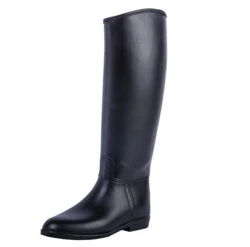Features and considerations for riding boots
2023-11-24
Riding boots are a fundamental piece of equestrian apparel designed to provide comfort, support, and safety for riders. These boots are specifically crafted for horseback riding, offering features that cater to the unique demands of being in the saddle. Here are key features and considerations for riding boots:
Key Features:
1. Heel:
- Heel Height: Riding boots typically have a low heel, often around 1 to 1.5 inches. The heel provides stability in the stirrup and prevents the foot from slipping through.
2. Sole:
- Smooth Sole: The sole of riding boots is smooth to prevent catching on the stirrup and allow the foot to slide out easily in case of a fall.
3. Toe:
- Toe Shape: Riding boots usually have a rounded toe, providing ample space for the toes and preventing discomfort during prolonged periods in the stirrups.
4. Material:
- Leather: Leather is a common material for riding boots due to its durability, flexibility, and ability to provide a close and comfortable fit.
5. Height:
- Tall or Short: Riding boots come in various heights. Tall riding boots extend up the leg, covering the calf, and are commonly used in English riding disciplines. Shorter boots, such as paddock boots, provide ankle support and are often used in conjunction with half chaps.
6. Lining:
- Comfort: Quality riding boots often feature a comfortable lining, which can be made from leather or synthetic materials, providing comfort and moisture-wicking properties.
7. Zipper or Laces:
- Closure: Some riding boots have zippers for easy on-and-off, while others may use laces. The choice depends on personal preference and the specific needs of the rider.
8. Elastic Gussets:
- Flexibility: Many tall riding boots have elastic gussets along the sides or back, allowing for flexibility in the calf area and providing a better fit.
9. Stitching and Detailing:
- Aesthetics: Riding boots often feature decorative stitching, detailing, or specific patterns, contributing to the overall aesthetics of the boot.
Considerations:
1. Purpose and Discipline:
- Choose Accordingly: The type of riding boot you choose may depend on your specific discipline or purpose. Dressage riders, for example, often opt for tall boots, while Western riders may choose cowboy boots.
2. Fit:
- Comfortable Fit: Proper fit is crucial for comfort and safety. Riding boots should provide support without causing discomfort or restricting movement.
3. Break-In Period:
- Allow for Adjustment: New riding boots may require a break-in period. Give yourself time to adjust to the boots and let them conform to the shape of your feet.
4. Maintenance:
- Regular Cleaning: Leather riding boots require regular cleaning and conditioning to maintain their appearance and durability.
5. Waterproofing:
- Weather Considerations: Consider waterproofing if you ride in wet or muddy conditions to protect the leather and keep your feet dry.
6. Ankle Support:
- Paddock Boots and Half Chaps: If ankle support is a priority, paddock boots combined with half chaps might be a suitable alternative to tall riding boots.
7. Budget:
- Quality vs. Price: Investing in quality riding boots can provide long-term comfort and durability. However, there are also budget-friendly options available.
8. Safety Standards:
- Certification: Some disciplines may have specific safety standards for riding boots. Check the requirements for your chosen discipline.
Riding boots are an essential part of an equestrian's wardrobe, providing both functional and aesthetic benefits. Choosing the right pair depends on individual preferences, riding style, and specific discipline requirements. Prioritizing comfort, fit, and safety ensures an enjoyable riding experience.



